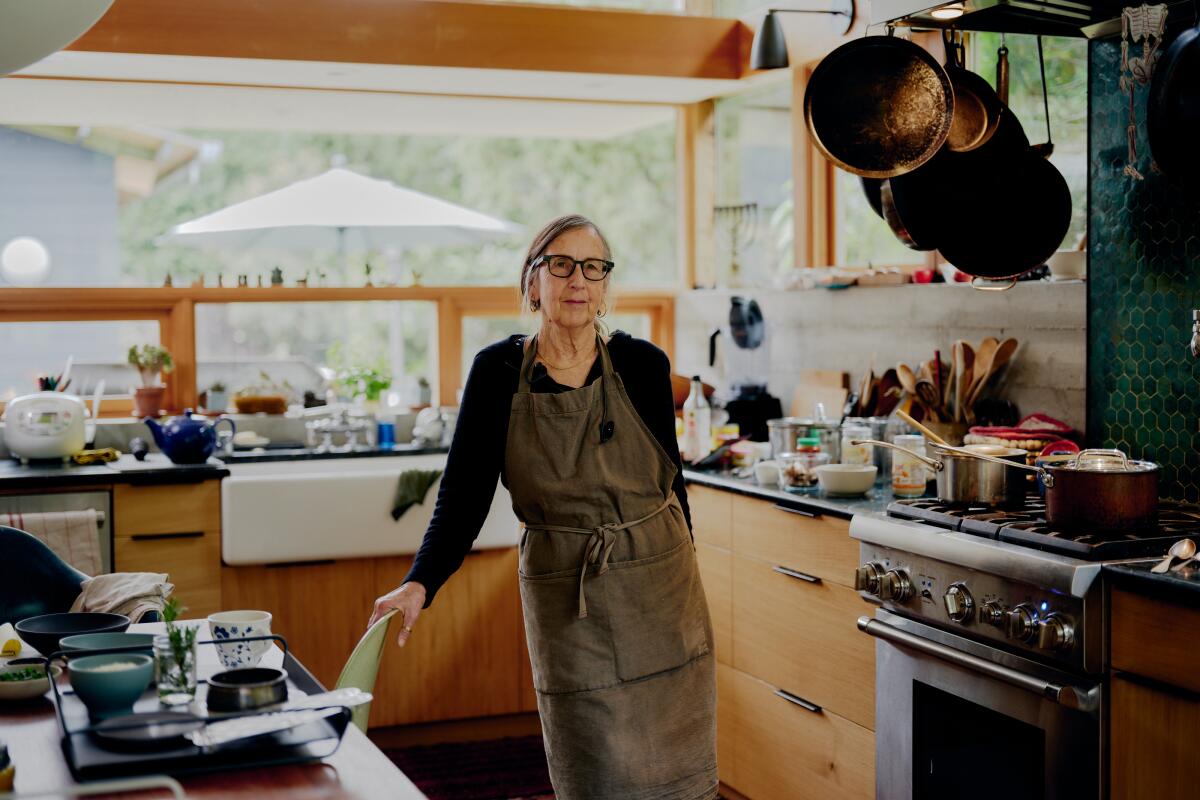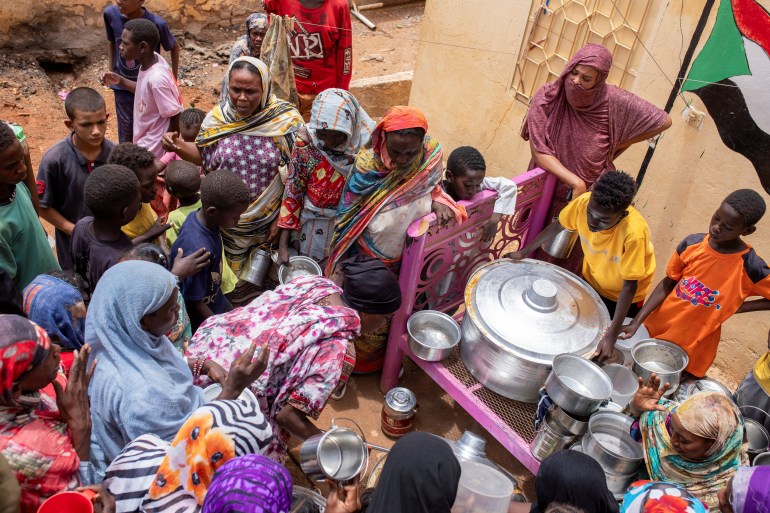Their dream kitchens burned down. What got them cooking again
Two cooks talk about loss and recovery. Plus, our summer cook-along with “Chef That!” Also, advice on cooking for dogs and eating with dogs, taquito comfort and fan-service restaurants (or what Day 1 was like at the Tesla Diner). I’m Laurie Ochoa, general manager of L.A. Times Food, with this week’s Tasting Notes.
Kitchen dreams
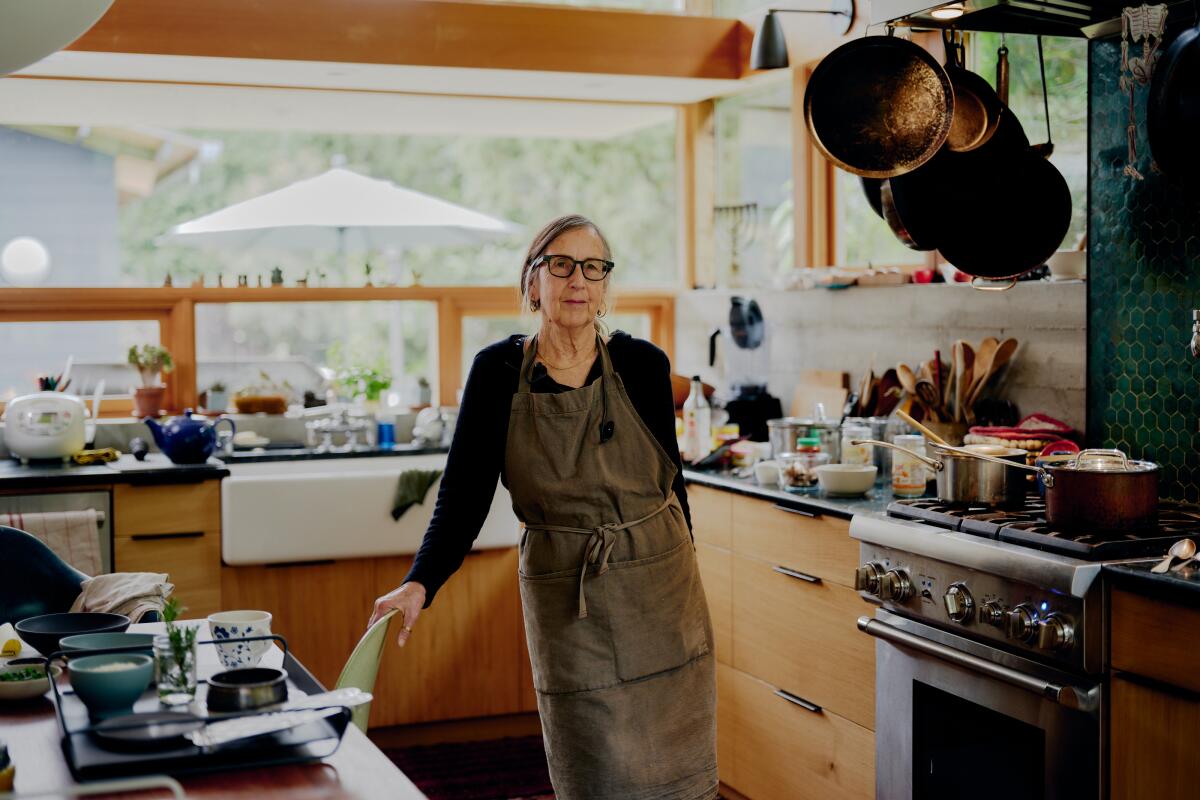
Michelle Huneven in her Altadena kitchen before it was destroyed along with the rest of her home in the Eaton fire.
(Shelby Moore/For The Times)
The most beautiful kitchen I ever cooked in was far from perfect. It was built into one of six Pasadena apartments that in the 1920s had been carved out of a Victorian mansion designed by Frederick Roehrig, the architect behind Old Town Pasadena’s Hotel Green and its surviving annex, Castle Green.
The dining room and kitchen had once been a grand parlor room with a fireplace at one end and most of the original wood details still on the walls and ceiling. The kitchen’s counter curved with the arc of several windows set into the bend of one wall, with soft sunlight filtering in through the greenery planted outside.
But the stove, relocated and updated since the days Jonathan Gold and I occupied that apartment, was a finicky old thing. And the counter, so attractively placed, was too low for serious cooking. Our backs would often ache if there were too many vegetables to chop or dishes to wash.
It was a dreamy kitchen, but it wasn’t a dream kitchen. And yet, we made some of our happiest meals there.
There are cooks I know who have had dream kitchens, spaces that were designed just for them and functioned according to their specific cooking needs.
Ruth Reichl, author and former restaurant critic and editor, says she designed her U-shaped kitchen to fit her body and the open floor plan of the home she and her husband, Michael Singer, share in New York’s Columbia County. With expansive views of the upper Hudson Valley, it’s inviting but also intimate in its footprint; no more than two or three steps are required to reach most of her appliances and tools. During parties, Reichl is easily able to roll out pie dough while catching up with early-arriving guests and there is lots of counter space around the U for setting out platters of food that always tempt some hungry person before it’s officially time to eat.
Closer to home, I was lucky enough to be invited many times to the Altadena home of Michelle Huneven, novelist and food writer (often for this paper), and Jim Potter, an attorney specializing in environmental law and an accomplished bread baker. From big, crowded Seders at Passover to weekday soup meals, always with something wonderfully sweet at the end, I watched their modest cooking space expand and evolve into a beautiful, functional and comfortable modern space with a dining table at the center of the room that allowed guests to watch the interplay of two excellent cooks at work.
“I had a little 1,000-square-foot house, and when Jim and I married, that was fine for a while,” Huneven said recently in the Times Test Kitchen. “Then he began to bake bread. And very shortly, everything in my little kitchen was covered with bread glue. I was like, ‘We need a bigger kitchen.’ Before we knew it, we’d designed a great big freestanding kitchen. I’m short, so in the place of overhead cabinets, we had windows out to our garden. He had his breadmaking area; I had my cooking area. We each had a sink. He had his own oven. And he had his own dishwasher. Praise the Lord.”
Cookbook author Molly Baz‘s dream kitchen in Altadena was one I never saw in person but I interacted with it virtually through her “Hit the Kitch” video series and Instagram feed.
“My home kitchen was also my place of work,” Baz said, sitting alongside Huneven in the Times Test Kitchen. “My husband, [Ben Willett], designed the space as the heart of the home. It was an expansive space that was a hanging-out living room, lounge, bar, kitchen, all in this one large room. We designed the kitchen very intentionally to be the anchor of like everything I do, the place where I would shoot my cookbooks and all of my content, where I would develop all of my recipes. So we decided to do it all butter-colored, and it was just this beautiful monochromatic, creamy butter-yellow-colored dream.”
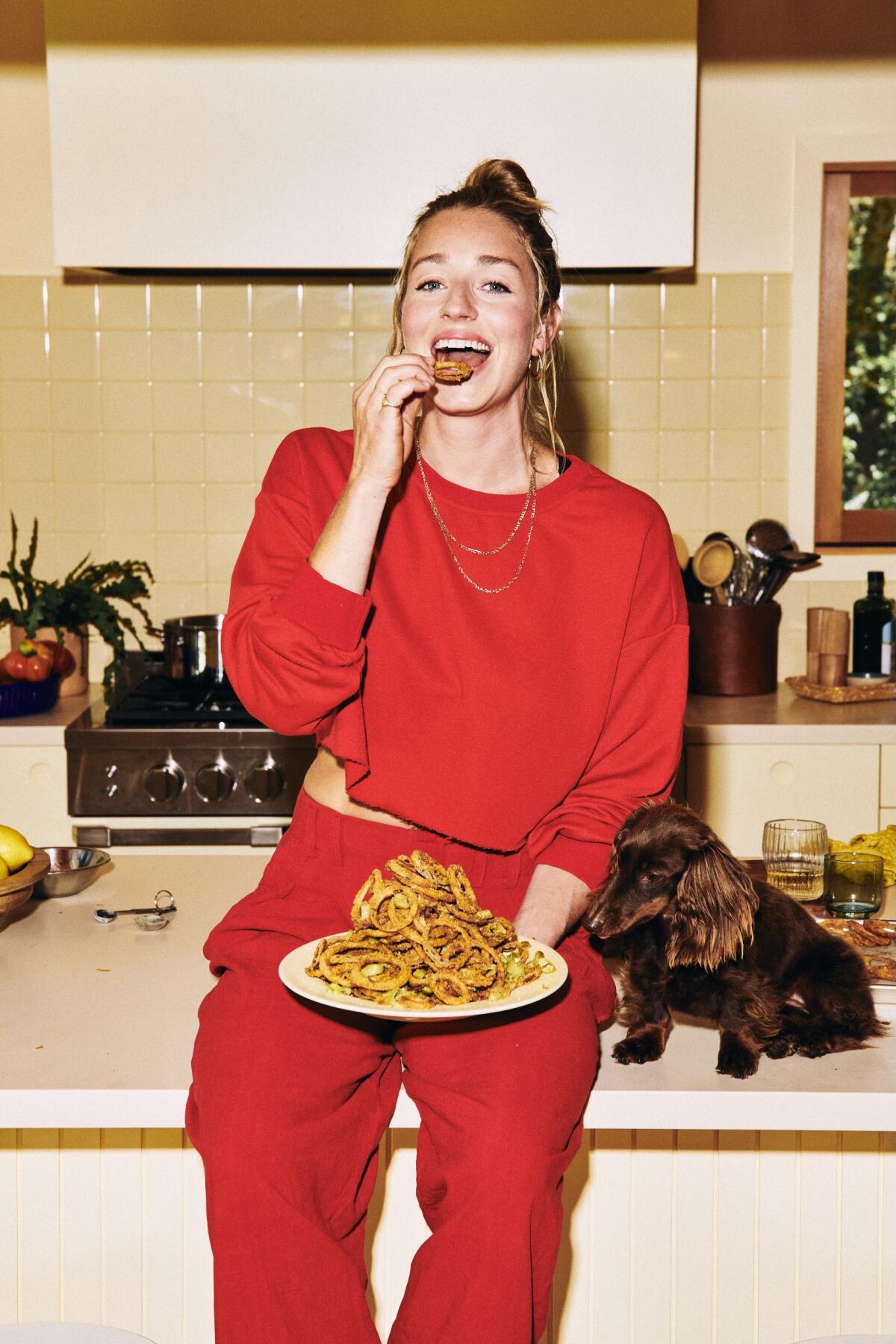
Food personality Molly Baz in her butter-yellow Altadena kitchen before her house was destroyed by the Eaton fire.
(PEDEN + MUNK)
As you’ve undoubtedly surmised by now, both Huneven and Baz lost their Altadena homes — and their dream kitchens — in the Eaton fire.
“We evacuated to a friend’s house about 4:30 in the morning with another couple who lived much closer to Eaton Canyon,” Huneven said. “When they learned that their house had burned, I found that so shocking that I just sat there with my hands over my mouth for about, I don’t know, 15 minutes. I just couldn’t absorb it. Then, at about 8 o’clock, Jim decided to drive up to our house. He later told me he’d known even before he drove up because he controlled the sprinklers and the solar panels from his phone, and nothing was responding. When he called me to say it was gone, he sent a picture of the house on the corner still burning with flames coming out of the windows, not a fire truck in sight. I was preconditioned for the loss, because I’d already reacted to one home burning down. I didn’t cry until 48 hours later.”
Baz’s story is similar. “I evacuated earlier, at 7:30 p.m., because some friends and neighbors had seen the fire, and it was creeping closer and closer,” she said. “We never got a notice, but we decided, let’s get out of here. Throughout the night, we were refreshing our phones, watching the map get populated with new homes that had burned. But the whole night, I was under the impression that my house had somehow by the grace of God gotten skipped because of this map. In the morning, my husband wanted to go to the house just to triple check and so, he got in the car and drove nervously up there. I got a call about 30 minutes later and he was just in tears. He was like, ‘There’s nothing left.’ ”
Huneven, whose newest, highly praised novel, “Bug Hollow,” is anchored in Altadena, her longtime home, and Baz, who came to Altadena from Brooklyn in 2020 and started the mayo/sando sauce brand Ayoh! last year, are both terrific cooks with very different styles. When Baz came into the Times Test Kitchen to record a video demonstration of the highly craveable pistachio halva chocolate chunk cookie recipe she created for her second cook book “More Is More,” I thought Huneven and Baz might want to meet each other. During their conversation about their experiences of loss and recovery, recorded by video producer Mark E. Potts, they immediately found things in common.
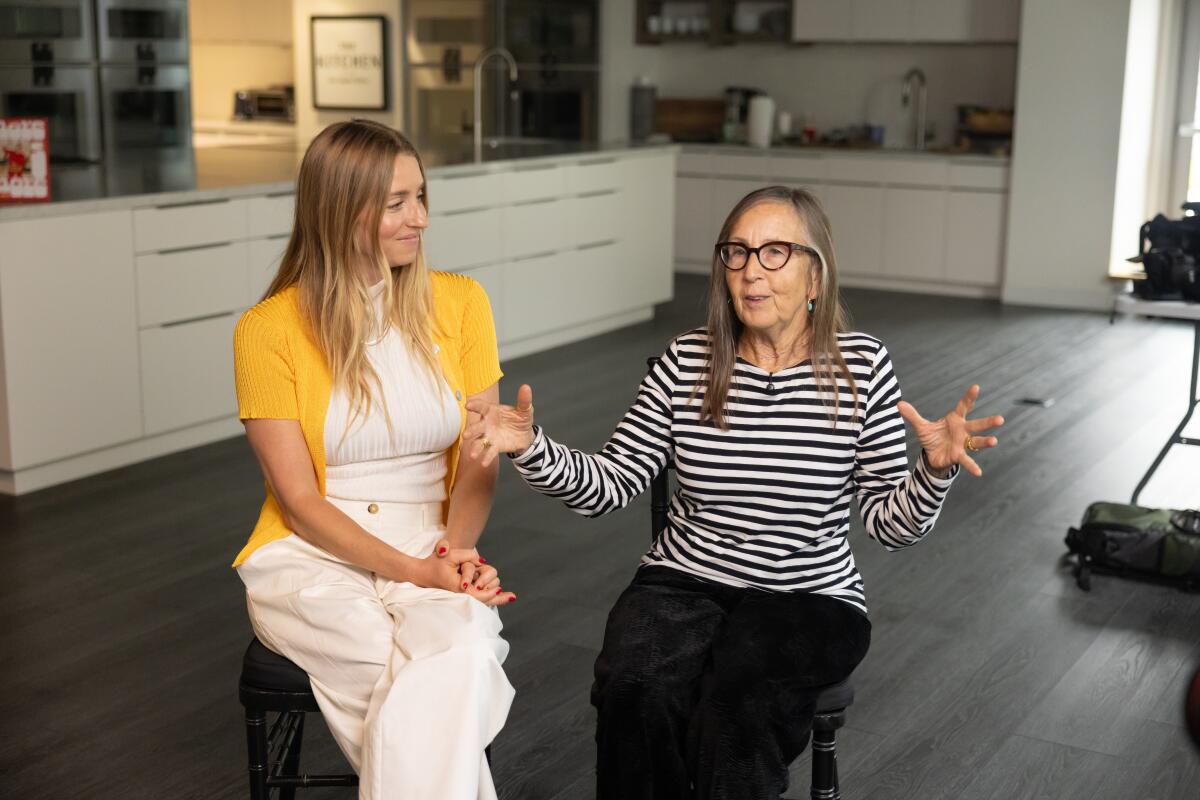
Molly Baz and Michelle Huneven in conversation at the Los Angeles Times Test Kitchen.
(Catherine Dzilenski / For The Times)
“One of the things that I wanted in the kitchen was a sofa,” Huneven said, “so we had this beautiful, long window seat with big welted cushions. Every morning we would wake up and drink our tea and coffee there with the dog and look out into the garden and get ready for the day.”
“We also had a sitting area where we would start the day,” Baz said. “We had a built-in couch that my husband designed, the first coffee table he ever made, and a chaise longue, which didn’t really have a use until I had my son 10 months ago. It became the perfect place to nurse. I would have my coffee and nurse him on the chaise longue every morning. It was just kind of a perfect place.”
After the fire, neither Huneven nor Baz felt much like cooking.
“I rebelled,” Huneven said. “I didn’t cook for two months. Or, rather, I cooked like two dinners, and it was the same dinner where I stuck a bunch of cherry tomatoes on a sheet pan, boiled some pasta and that was it, with maybe some burrata. I don’t even remember how we ate. I mean, I say I wasn’t traumatized, but it really was a blur.”
“I didn’t cook for a while either,” Baz said. “I got back into the kitchen to finish a recipe I was working on the day of the fire. It was a savory egg quiche, but treated like a burnt Basque cheesecake, cooked at a really high heat, a crustless quiche. I thought about taking it with me when we evacuated, but I expected I’d be back the next day. One of the the last things I said before I left was, ‘Damn, I just wish the quiche was a little more burnt.’ Because I had this vision of a really burnished exterior. And so later the quiche got burnt. Once I pulled myself together enough to think about food, that’s the next thing I made. It was really comforting and cathartic. I made everyone leave the kitchen and was like, ‘I’m cooking. I need to be alone.’ So it was a bit of a therapy session for myself. And yeah, the quiche was delicious.”
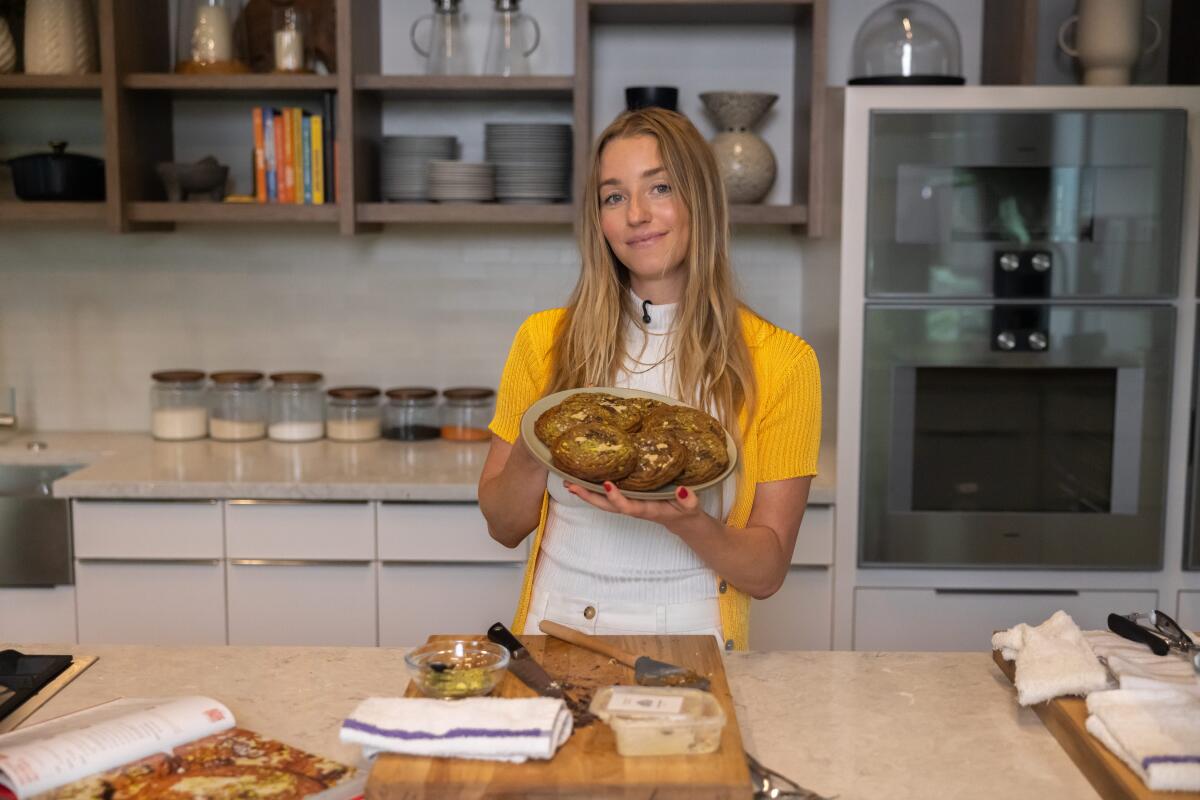
Molly Baz with a just-baked batch of her pistachio brown butter and halva chocolate chunk cookies at the Los Angeles Times Test Kitchen.
(Catherine Dzilenski / For The Times)
Both Baz and Huneven are now living in different rental homes in Echo Park while they figure out the logistics of rebuilding.
“So much of cooking is a graceful dance,” Baz said, “and I felt so ungraceful for the first three weeks that it made me not want to cook. I’ve gotten over that hump, and I think I’m regaining my muscle memory in this new space now. I feel like I can cook and not fumble around.”
“We moved into a completely empty house, nothing in the drawers. We had a couple of camping pans that had been in the trunk of our our truck. But one of the things that was so amazing is that we landed in a sea of generosity. I’m not wearing any clothes that I bought. They’re all gifts. And people furnished our kitchen with a house-warming party, but it was really a kitchen warming.
“The incredible kindness and generosity of people, that’s a gift I never anticipated,” Huneven continued. “It’s also really lessened the trauma. Because, you know, it’s stuff, and it can be replaced. Houses can be rebuilt. Somebody said to me, ‘This is the worst thing that’s ever happened to you.’ And I’m like, ‘No, it’s not.’ You know, the loss of people that I’ve loved, some bad breakups in my youth. Now those were bad. This was bad too, but it’s not the worst thing.”
“We lost all of the physical things,” Baz said, agreeing with Huneven. “But it highlights what you do have, which is your relationships and your community. And that becomes the most important thing in the world. My friends and my family, the people who are holding me together in all of this, are everything to me right now. All of the bulls— just washes away. You learn and understand like that living is actually about humanity and people. The rest can burn down, and you’re going to be OK.”

Newsletter
You’re reading Tasting Notes
Our L.A. Times restaurant experts share insights and off-the-cuff takes on where they’re eating right now.
You may occasionally receive promotional content from the Los Angeles Times.
Summer cook-along
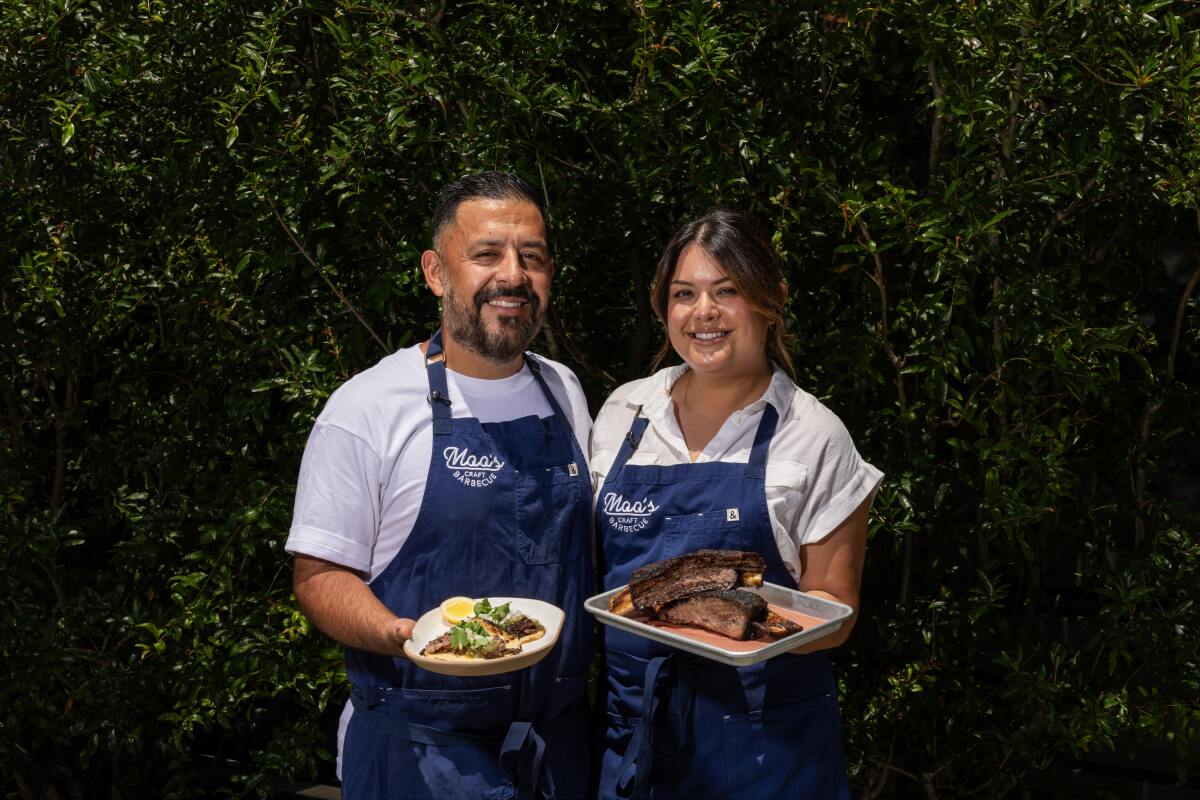
Andrew and Michelle Muñoz with beef ribs, beef rib tacos, and salsa outside the Los Angeles Times Test Kitchen.
(Catherine Dzilenski / For The Times)
Baz is just one of the cooks and chefs who have been to the Times Test Kitchen in recent weeks to meet our “Chef That!” challenge: Come up with a recipe that demonstrates chef skills and creativity but is still simple enough for an average home cook to make. Our “Chef That!” video series is ongoing, but this Sunday we’re publishing a special cook-along recipe section full of summer recipes from the chef series plus a few from cookbook authors in our “Book to Cook” video series. Among the recipes to look for, home-oven-cooked beef ribs with outdoor smoker flavor from Andrew and Michelle Muñoz of Moo’s Craft Barbecue, spicy cold mung bean noodles from 88 Club’s Mei Lin, Hailee Catalano‘s “mean, green” turkey sandwich, the egg salad sando that Father’s Office founder Sang Yoon serves at his Helm’s Bakery complex in Culver City and an incredible grapefruit cream pie from Quarter Sheets’ dessert guru Hannah Ziskin.
Dog days
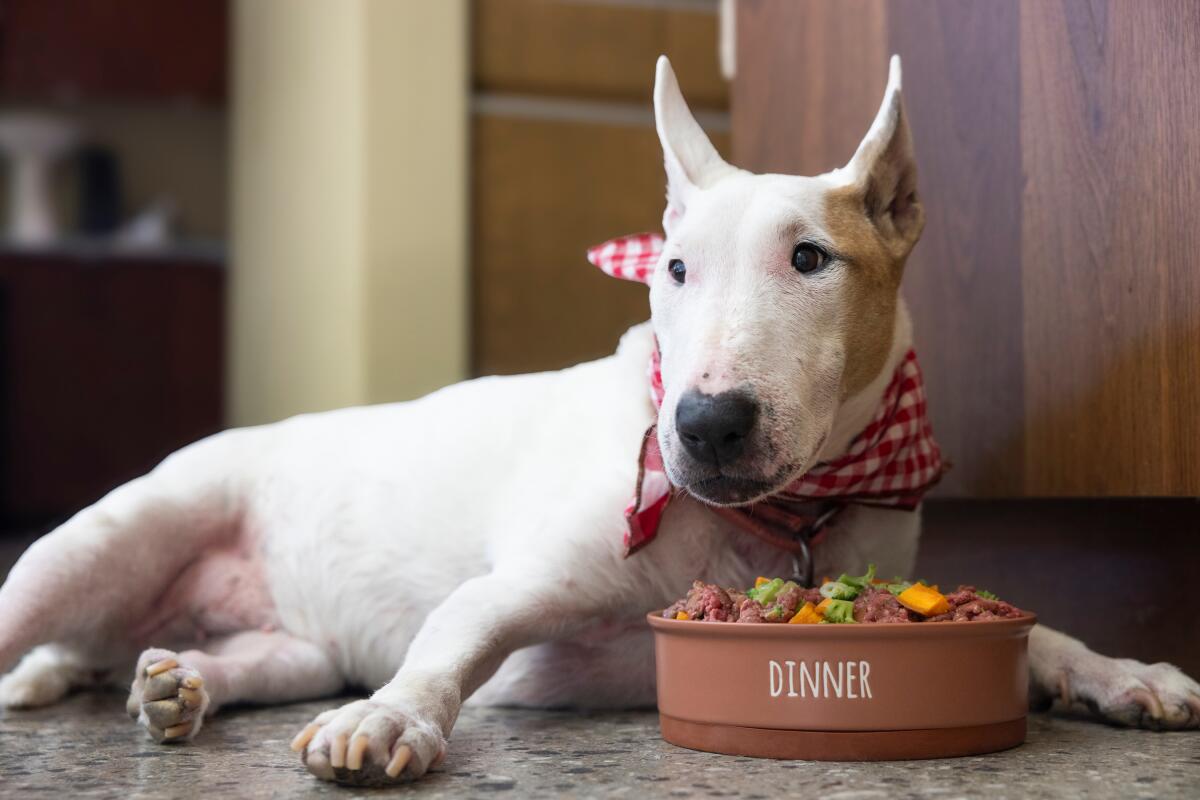
Photographer Anne Fishbein’s bull terrier Ivy with dog food made from recipes by writers Carolynn Carreño and Michelle Huneven.
(Anne Fishbein / For The Times)
Los Angeles, says senior Food editor Danielle Dorsey, is ranked the nation’s most popular city to own a dog. It’s also a very good city for eating out with a dog. Dorsey put together a guide to the best dog-friendly patios to take your pup as part of our “Dog Days of Summer” collaboration with our features team. Regular contributor Carolynn Carreño explored the evolution toward human-grade dog food over the last 15 years and provides a recipe for Rufus hash, a raw dog food blend she used to make for her late dog, Rufus. It’s made with ground beef, turkey or chicken, organ meat, bone meal, steamed broccoli and steamed sweet potato. Novelist Michelle Huneven (see story above) also shares her recipe for the homemade hash she feeds her rescue dog, Tatty Jane. Like Carreño, she uses ground meat and broccoli (or spinach) but also includes peas, brown or white rice, fish oil or sardines, finely ground baked eggshells for bone health and, for the antioxidants, frozen-fresh cranberries.
The comfort of taquitos
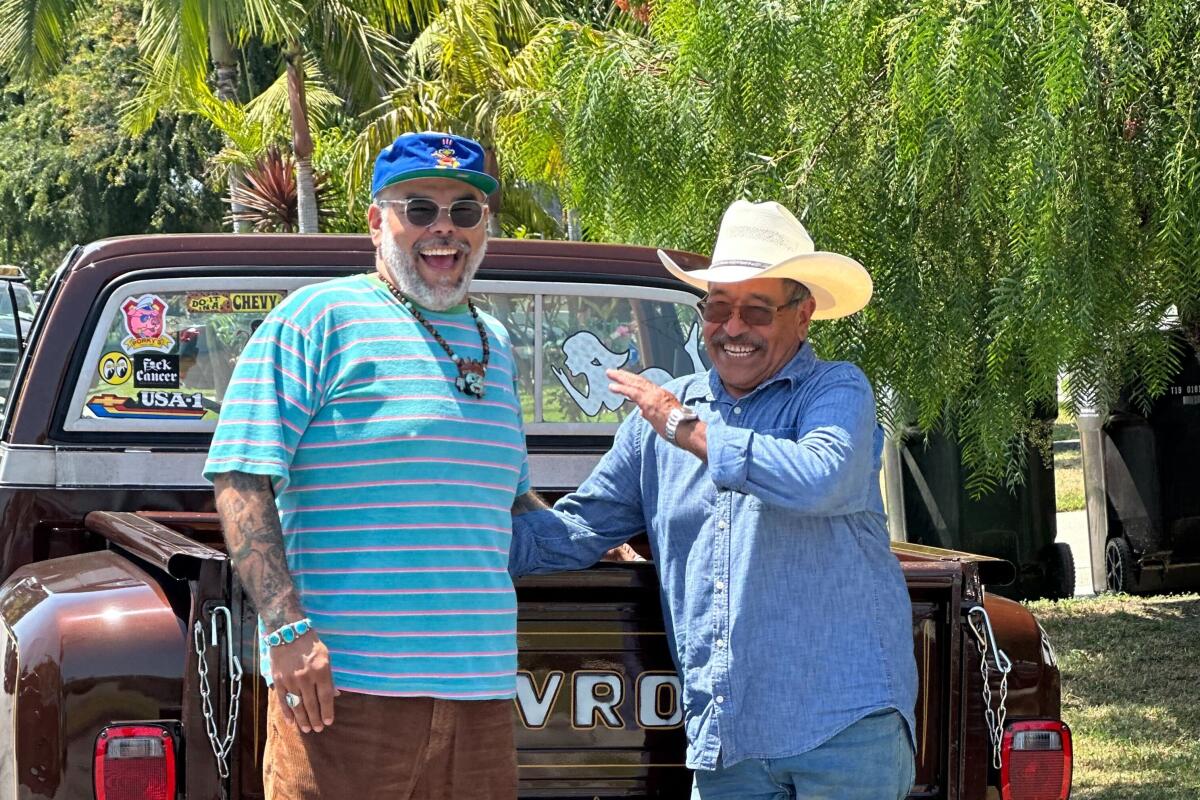
Chef Wes Avila, left, with his father, Jose Luis Avila, in Pico Rivera in 2025.
(Wes Avila)
Chef Wes Avila‘s father, Jose Luis Avila, is a legal resident of the U.S. But he felt so fearful of being caught up in the ICE raids happening all over California that after more than 50 years in this country he recently moved to Mexico. Avila told Food reporter Stephanie Breijo that when he’s missing his father he makes a version of the Durango-style caldillo, or stew, that his father used to cook.
“It connects me to him,” said Avila, who leads the kitchens at MXO and Ka’teen. “I talk to him every other day. We have a very close relationship.”
And when he’s missing his mother, who died in 1995, he makes beef taquitos, which he thinks was her favorite dish — or at least, he says, “our favorite dish for her to make when my brother, my sister and I were kids.” He shared recipes for both dishes.
Also …
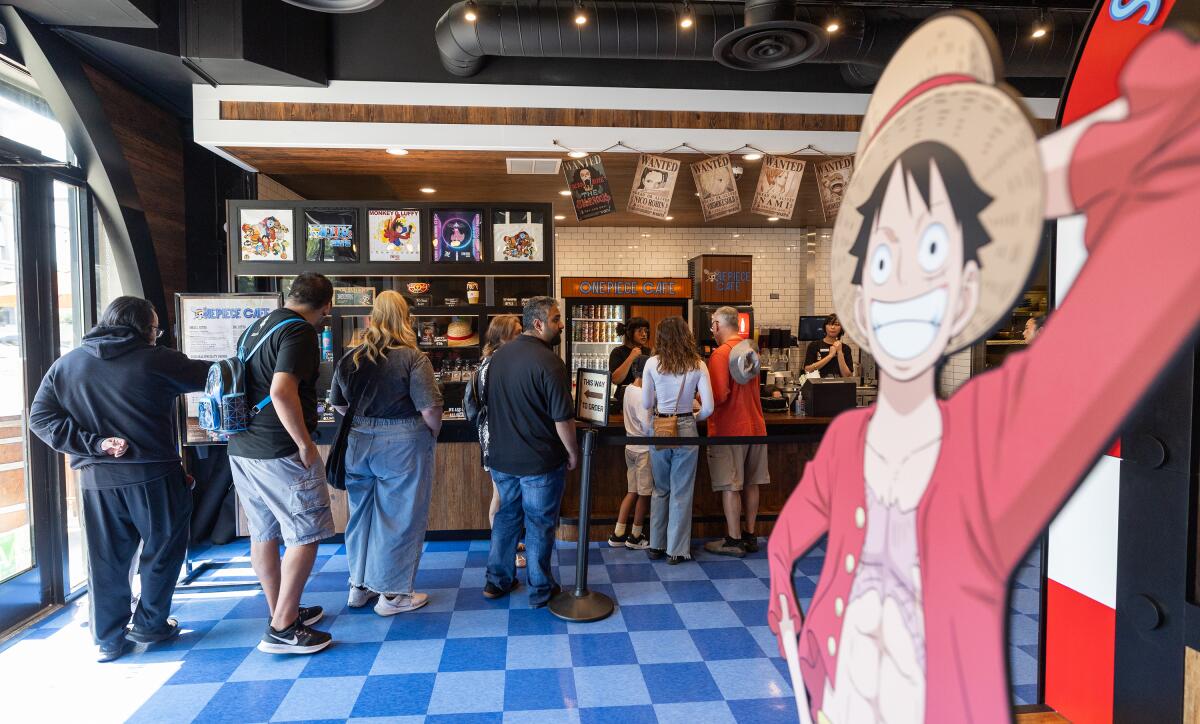
The lunch line at One Piece Cafe in Little Tokyo.
(Myung J. Chun/Los Angeles Times)
- In a time of too many restaurant closures, two very different but fan-driven new restaurants are drawing big crowds. Karla Marie Sanford talked with diners lined up in Little Tokyo for One Piece Cafe, based on the longtime anime and manga series. “‘One Piece’ has a pretty big community,” a fan told Sanford, “and especially with the Lakers and Dodgers collaborating with One Piece, L.A. is bringing anime into their culture as well.” And on Day 1 of the Tesla Diner, reporters Lauren Ng and Stephanie Breijo showed up at the fully electric 24-hour restaurant where they found a protester decrying Tesla CEO Elon Musk as a threat to democracy while Tesla aficionados lined up for smashburgers and more from the diner menu created by chef Eric Greenspan. Whether either restaurant will last beyond the curiosity phase remains to be seen.
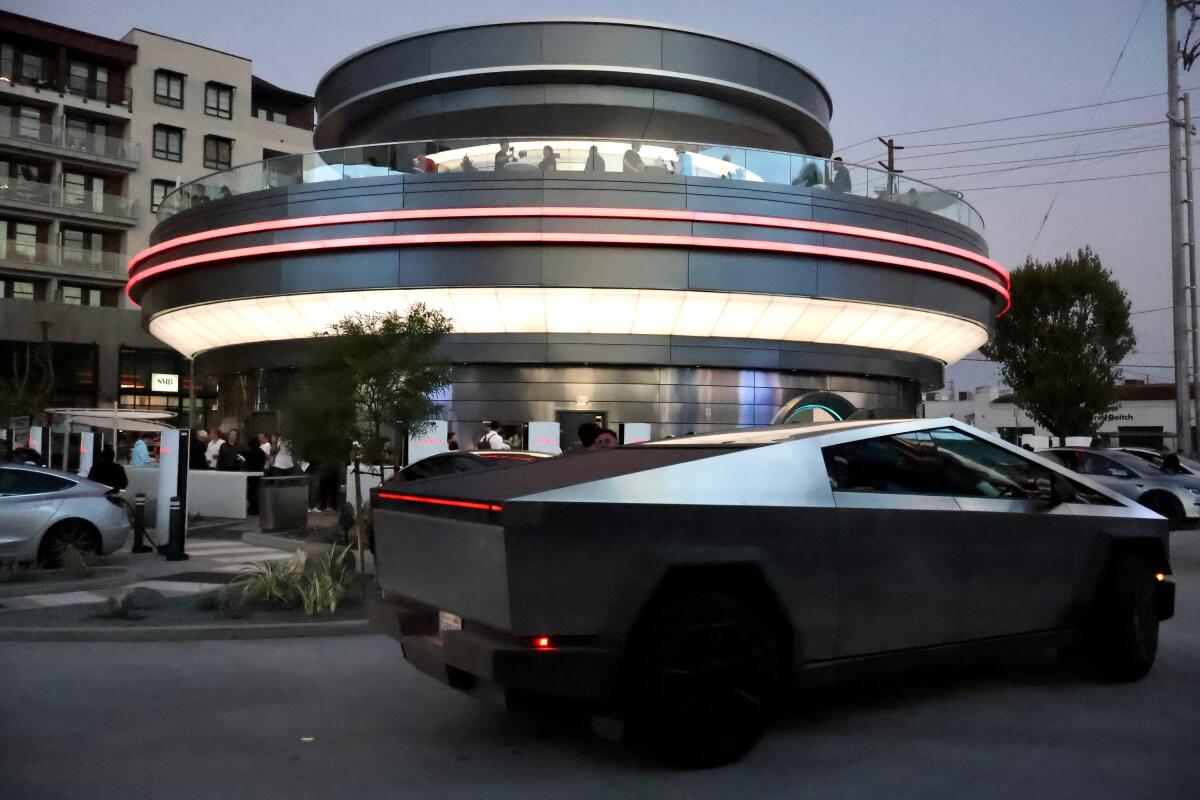
The Tesla Diner.
(Lauren Ng / Los Angeles Times)
- In this week’s Quick Bites, Breijo has details about the return of Ohana Superette in Silver Lake, from Eric and Miriam Park, serving “thoughtful, traditional poke”; Lasita‘s new weekend cafe Kapé, “a daytime-only Filipino cafe that riffs on meryenda culture” from Nico de Leon and Chase and Steff Valencia; the newest location in Highland Park of Sogo Roll Bar; a new Manhattan Beach branch of the Bill Addison-praised sandwich shop Bread Head; and notes on Dine LA’s two weeks of “special items and limited-run prix-fixe menus” from nearly 450 restaurants across L.A. County.
- Lauren Harvey reports that the New York City Office of Chief Medical Examiner determined this week that popular Food Network host Anne Burrell died by suicide June 17. “Her previously recorded final season on ‘Worst Cooks,’ co-hosted with Gabe Bertaccini, is scheduled to premiere July 28.”
- Piper Heath reports on In-N-Out Burger owner and Chief Executive Lynsi Snyder’s decision “to establish a corporate office in Franklin, Tenn.,” a state where there are currently no In-N-Out locations but where she plans to move her family. She also plans to shift the chain’s California offices from Irvine to Baldwin Park.
-
And Dee-Ann Durbin reports on Coca-Cola‘s decision to “add a cane-sugar version of its trademark cola to its U.S. lineup this fall, confirming a recent announcement by President Trump.” She notes that “Coke currently sells Mexican Coke, which is made with cane sugar, in the U.S.”
Newsletter
Eat your way across L.A.
Like what you’re reading? Sign up to get it in your inbox every week.
You may occasionally receive promotional content from the Los Angeles Times.

